Apples are the most important temperate fruit crop in the North Western Indian Himalayan region. One of the healthiest fruits is praised for its ability to keep diseases and doctors at bay. The Apple is a universal wonder. Since Apples are healthy and tasty, they are the most consumed fruit. Although Apples come in many types and varieties, they have different health benefits and tastes.
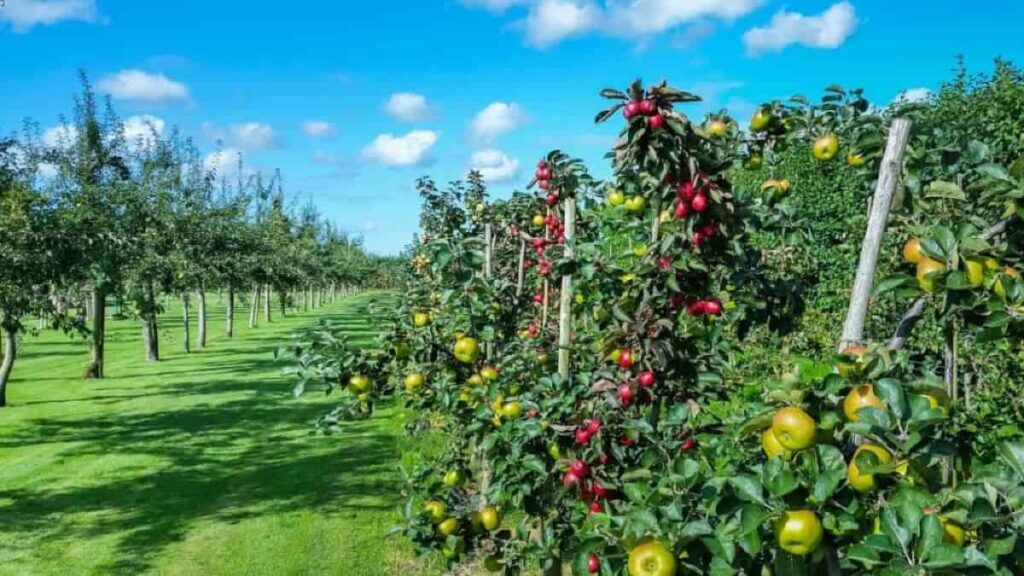
After oranges, bananas, and grapes, it is the world’s fourth most widely produced fruit. Due to its high consumption and medicinal value, it is also considered the most profit-making fruit crop. China is the world’s leading Apple producer. Kashmir, Himachal Pradesh, and Uttarakhand are the most popular places in India where it is grown. Besides Nagaland and Sikkim, Apple cultivation was practiced in Arunachal Pradesh, Nagaland, and Meghalaya.
Compared to the total Apple production of the world, India accounts for only 2.1% of the total Apple production. It is estimated that there are 620 thousand acres under Apple cultivation in India, which produce 1470 thousand metric tons of fruit per acre, resulting in a productivity of 2.4 tons per acre. A total of 4.1 tons of Apples are produced per acre in Jammu and Kashmir, the highest productivity state in India for Apples. Let’s check out high yield hybrid apple varieties in India below.
Climate required for cultivating Apples
Temperate regions are the best places to grow Apples. Despite this, Apple-growing regions in India do not fall within the temperate zone; rather, the Himalayan mountain ranges and the region’s high elevation cause the region’s predominant temperate climate. The summertime average temperature should be between 21 and 24°C during the actively growing stage. For optimal color development, Apple trees thrive in areas with continuous wintertime rest and plenty of sunshine.
Between 1500 and 2700 meters above sea level, it can be grown. A well-distributed rainfall of 1000 to 1250 mm throughout the growing season is ideal for Apple tree growth and fruitfulness. Most commercial Apple tree varieties do well in cold, rainy climates, with chilly winters and cool springs and summers.
It is common for Apple trees to have low yields, particularly in tropical areas, although this is not caused by the weather or a lack of cold. Rainfall frequently deteriorates the crucial stage of pollination. However, cultivating Apple trees for commercial purposes in tropical climates is challenging. It needs rigorous testing (growing at least ten kinds annually) and improvements to pollination, watering, fertilizing, and harvesting.
High Yield hybrid apple varieties in India
Sunehari
A hybrid variety developed in India results from a cross between an ambri Apple and a Golden delicious variety Apple. They have yellow peels with crimson streaks. It has a sweet, acetous flavor with crunchy, juicy flesh.
Chaubattia Anupam
The Chaubattia Anupam is an Indian hybrid Apple, not a product of an Ambri cross. Developed by crossing Early Shanburry and Red Delicious, this variety dominates Apple orchards in Uttar Pradesh and Uttaranchal. With its glossy skin and vertical red stripes, the fruit is beautiful. In terms of taste, Chaubbatia Anupam is a delight to eat because of its aromatic, crunchy white flesh and zesty sweet-tangy flavor.
In case you missed it: High Density Apple Farming – Planting, Spacing, Yield In India
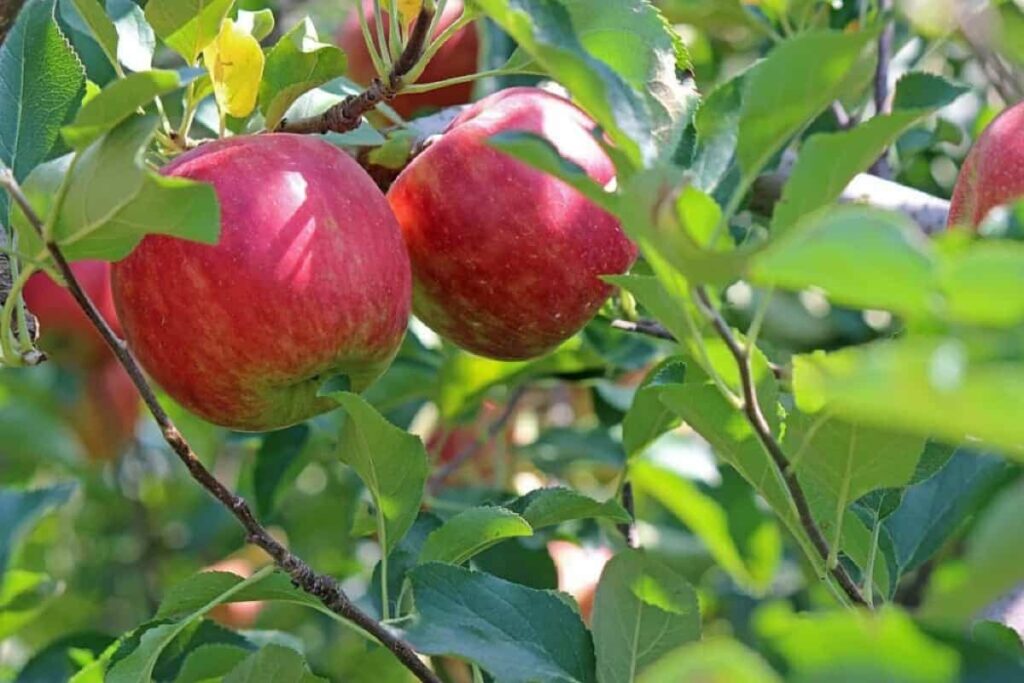
Lal Ambri
Interestingly, among the many hybrid Apples developed from the Ambri, the Lal Ambri is a relatively new variety in India. The resultant cultivar of the cross between the Ambri and the Red Delicious produces a fruit that exhibits smooth skin, bright red color, crisp, tender texture, and sweet, juicy flavor, which is a result of the crossing. As with their parent Ambris, Lal Ambris are native to Jammu and Kashmir and have excellent keeping properties.
Red Gold
A delicious Apple that tastes like no other Apple you have ever tasted, the Red Gold is undoubtedly one of the most popular varieties of Apples everywhere, including in India, and for a good reason. This shiny, deep red fruit grown mainly in Kashmir as a mid-season variation of the Golden Delicious tree is a hybrid of the Golden Delicious tree and the Red Delicious tree.
Honeycrisp
The Honeycrisp Apple retains its crispiness and shelf life for a long time and has a sweet-tangy flavor that makes it a great snack. It is recommended to consume these Apples raw or to use them as a beverage when they are raw. Since it can last its freshness for a long time and has a crispy texture, farmers can export it.
Honeycrisp Apples are some of the crispiest varieties you’ll find anywhere, not just in India. The juicy sweetness of these Apples complements their fresh crispness; they are excellent healthy snacks. The Honeycrisp Apple variety, however, is not cultivated in India but imported from other countries.
Fuji Apple
The Fuji Apple is characterized by its large size, round shape, and pale reddish-green skin. As a result of their crispy texture and sweet flesh, they are the first choice when it comes to raw consumption. The shelf life of these products is also much longer than that of conventional products.
An Apple that mixes the characteristics of both the Red Delicious and the Ralls Genet Apple. As far as the taste of the Fuji Apple is concerned, it has been described as spicy, sweet, and intense. Despite this, it is a sweet Apple, somewhat less acidic, and a little less dense than many other Apples, making it perfect for preparing galettes or tarts. It is also a perfect hand-fruit Apple.
Mollies Delicious
This variety is native to Himachal Pradesh and J&K, resulting from not one but two crosses. It is a very attractive piece with a conic shape and a very attractive finish. On a yellow background, it has a 50% red blush. Inside, they have a mild, sweet taste and juicy, crisp flesh that is greenish-white. Salads and baked goods can be made with them. August is the time when they are available. Cold storage keeps Mollies Delicious fresh for up to 10 weeks.
Golden Delicious
The Apples have pale green-yellow skin, as their name suggests. It is an Apple that is green to yellow, originating from the American continent. Its interior flesh is described as crisp, juicy, and sweet, although some critics find it bland. Cooking and blending the delicious golden Apple into purees and sauces is popular due to its rich flavor. It is theorized that this Apple is a hybrid of the “Golden Reinette” and the “Grimes Golden” varieties of Apples. It is mostly found in Jammu and Kashmir, as well as Himachal Pradesh, where it grows in abundance.
In case you missed it: Fertilizer Management for Apple Trees: Organic, Compost, NPK, and Schedule
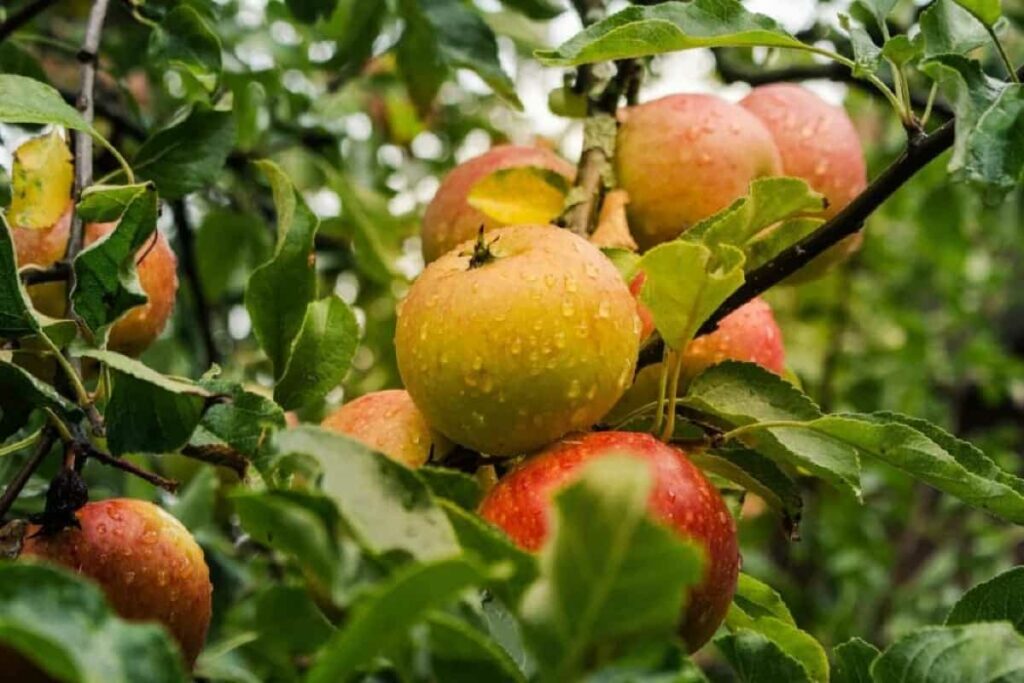
Tydeman’s Early
Many types of Apples are cultivated in Himachal Pradesh, Jammu, and Kashmir, but Tydeman’s Early Apples are mainly known for their red-scarlet skin on a yellow-green base. With its tarty-sweet flavor, this juicy variety is a wonderful addition to salads and desserts, as it is known for its tasty tartness. These are known as an early summer variety, and these Apples are known for their supreme taste and glossy appearance.
Winter Banana
As one of the world’s most exquisite types of Apples, the Winter Banana is a late-season variant produced in Himachal Pradesh in India. This fruit has a subtle banana-like flavor, which gives it its name. Pale yellow-skinned beauty with pinkish-red blush enjoyed its mildly sweet flavor as a dessert Apple.
Red June
It is also called Carolina Red June and is a typical early southern Apple. A deep red skin covers the yellow fruit, which is smaller and round to round-oblong in shape. Unlike early Apples, the flesh looks white with red staining and has a mildly brisk taste. Historically they were used for pies and cider as well. A late-blooming Apple tree is a heavy bearer and tends to bloom late for an early Apple. There is a possibility of Apple scabs and cedar rust on Red June.
India’s six most Apple-producing states.
Jammu and Kashmir
Around 77.71% of India’s Apple production comes from Jammu and Kashmir. Around 1800 tons of Apples are produced in this state.
Himachal Pradesh
Regarding Apple fruit production globally, Himachal Pradesh accounts for 19.19% of the total. In addition, unique kinShaktiman Grimme potato planter machines of Apples like Mollies, Rich-e-Red, Gala, Anna, and many more are produced in India.
Uttarakhand
About 2.52% of Apple plantations in India are located in Uttarakhand. Apple production techniques are also being improved in Dehradun by the government.
Arunachal Pradesh
By contributing 0.32%, Arunachal Pradesh remains India’s top Apple-growing state. Arunachal Pradesh provided 7.35 tonnes of Apples, which placed it third in the rankings.
Nagaland
In terms of Apple production globally, Nagaland accounts for 0.09%. Apples are grown by marginal farmers so they can earn a living. Two tons of Apples are produced by Nagaland farmers.
Tamil Nadu
Tamil Nadu ranks on this list with 0.01 tonnes of Apple production. Climate conditions in the state favor Apple farming due to low temperatures. As a result, Apple’s production will increase significantly.
In case you missed it: Top 16 Steps to Boost Custard Apple Yield: How to Increase Fruit Size, Quality, and Production
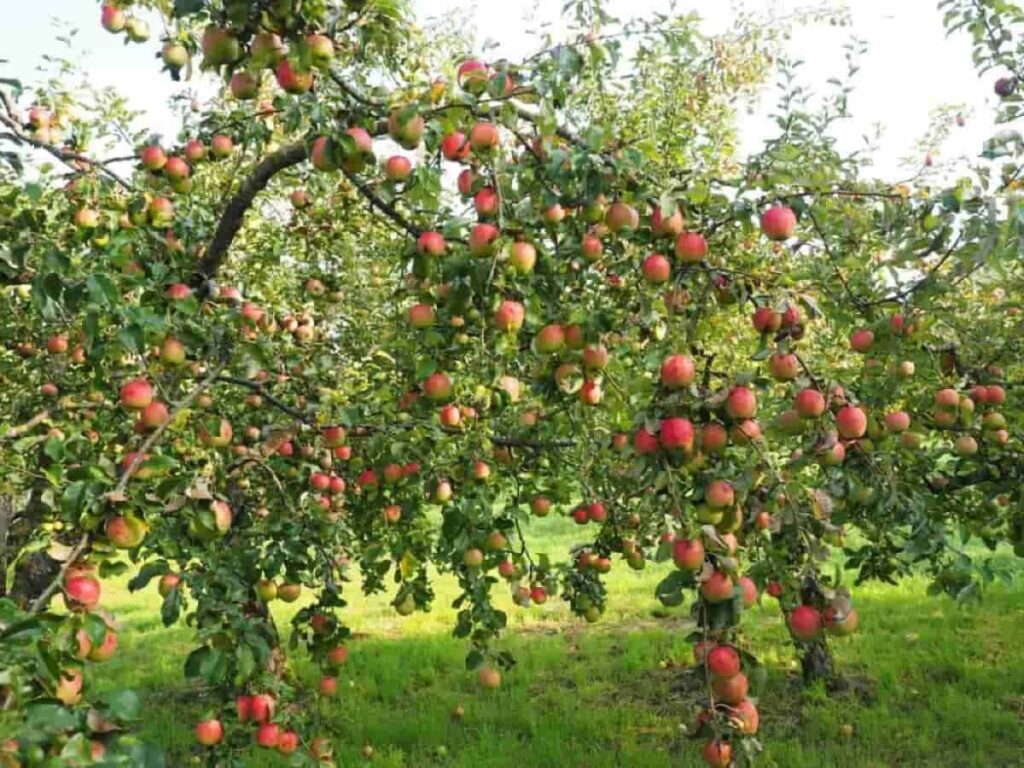
Popular varieties of Apples in India
| State | Varieties |
| Jammu and Kashmir | Golden Delicious (Late Season), Lal Ambri, Mollies Delicious, Starkrimson, Red June, Irish Peach, Benoni, and Tydeman’s Early |
| Himachal Pradesh | Golden Delicious (Late Season), Red Delicious (Mid-season), McIntosh |
| Uttarakhand, Uttar Pradesh | McIntosh, Chaubattia Anupam |
| Tamilnadu | Irish Peach and Zouches Pipin (Early); KKL 1, Carrington and Winterstein (Midseason); Rome Beauty and Parlin’s Beauty (late) |
Seasons in the Indian Apple Farms
Managing and maintaining an Apple farm takes a lot of work, beginning with the pruning process in the spring and ending with harvesting in the fall. So even though these two times of the year are the busiest on an Apple farm, a lot is going on throughout the year.
Spring
Blooming Season
An Apple farm is busiest in the spring because pruning takes place, which is time-consuming. Nevertheless, it is also a time when Apple trees are adorned with fragrant pink, white, and red blossoms. It is truly a breathtaking sight to see the whole scene.
Tiny Fruits
These Indian Apple farms start to sprout fruit buds after the Apple blossoms bloom and the petals fall to the ground. Eventually, these buds will grow into full-grown Apples, ready to be plucked after a few months.
Summer Season
Thinning
A crucial step in growing Apples is to thin the Apple trees in Indian Apple farms in the summer. A tree is pruned mainly to reduce the number of fruits it holds because if it doesn’t do this, all the Apples will not reach their maximum size because the tree won’t have enough space for them all. Many Apple trees are sprayed with hormones to help them drop some fruit, but organic Apple farms do it the old-fashioned way, by hand.
Harvest
In September and October, Apple harvesting takes place. However, in Himachal Pradesh, harvesting usually occurs between June and November. In Himachal Pradesh, Apple harvesting begins in different regions depending on altitude. Harvest season is one of Apple growing season’s busiest times, just like spring pruning. Apples must reach a uniform size and display their distinctive flavor and color at harvest time. Apples usually fall in the yellow-red color spectrum, depending on their type.
In case you missed it: A Step-By-Step Guide to High Density Fruit Farming: For Guava, Banana, Mango, Pineapple, Lemon, Papaya, Litchi, and Apple
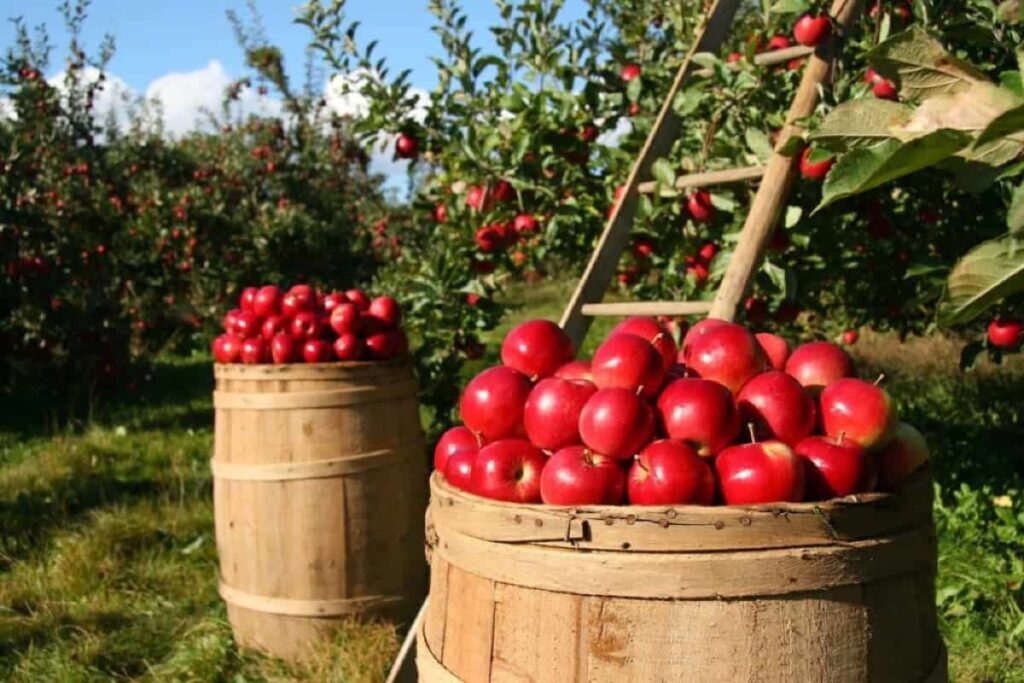
Autumn
Harvest Season Continues
Apple harvesting continues until November when workers gather in the orchards to help families pick Apples from dawn to dusk. In addition to being harvested, they are cleaned, neatly packed in boxes, and then loaded onto vehicles and transported for domestic sale. As well as exporting to international markets, the superior kinds are sold overseas.
Post-Harvest Care
The Apple farms are replenished with fertilizers or manure after the harvest season to prepare them for the following year. After bearing fruits, the soil’s nutritional value is greatly diminished. Fertilizers, such as nitrogen and potassium, or manure, are used by Apple farmers to replenish lost nutrients in their soil. Before the snow starts, all this is completed so that the manure will reach the roots slowly and efficiently when the snow falls on the ground.
Winter
Maintenance and Care
As the leaves fall off the trees in the winter, the Apple orchards become empty; the naked trees show off their beautiful shapes after the leaves have been shed. In winter, farmers can check for maintenance work around the orchard that they couldn’t complete during the busy season.
Harvesting Apples
Apples are usually ready for harvest from September to October, except in the Nilgiris, where the season is from April to July. Depending on the variety, the fruits take 130-150 days to mature after the full bloom stage. Ripening of fruits is characterized by a change in color, texture, and quality, as well as a development of the characteristic flavor. The fruits need to be uniform, firm, and crisp when harvested.
Depending on the variety, the skin at maturity is yellow-red. However, the optimal harvest time depends on the fruit’s quality and the anticipated storage period. With the introduction of dwarf rootstocks, hand picking is recommended as it reduces bruising due to fruit fall during mechanical harvesting.
Apple tree yield
From the fourth year onwards, Apple trees start bearing fruit. An Apple tree grown in a backyard that is well-cared for will produce about 80 to 150 fruits each season. However, when Apple trees are cultivated commercially in Apple orchards, with sophisticated pollination, fertilization, irrigation, and plant protection methods, they can produce 400 to more than 800 (and in some cases over 1200) fruits per season. A well-managed Apple orchard yields between 10 and 20 kg per tree yearly, depending on variety and season.
In case you missed it: How to Start Apple Farming in USA: A Step-by-Step Planting to Harvesting, and Production Guide
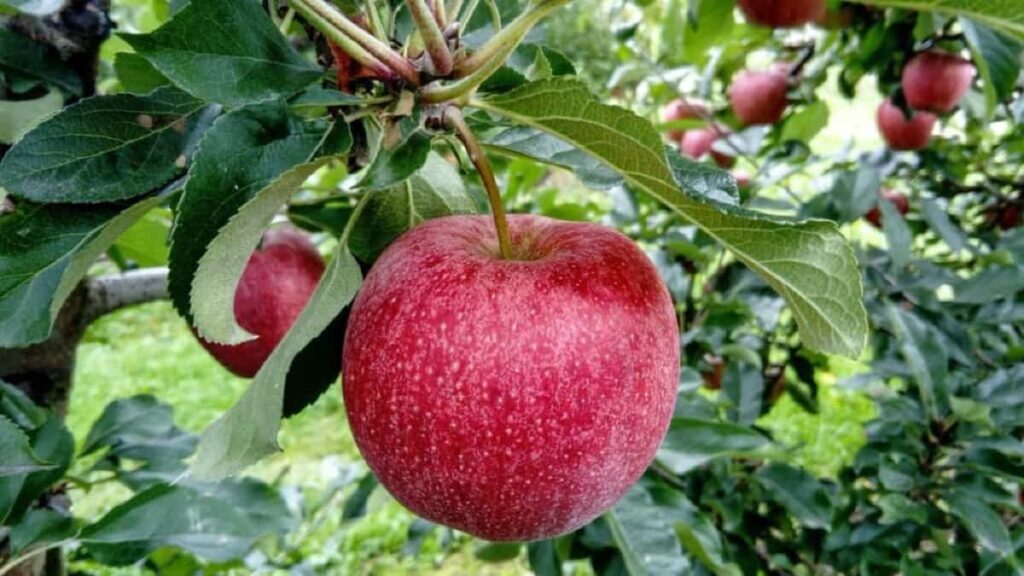
Tips to increase Apple yield
- For high yields, balanced nutrition is essential. A high yield depends on the number of fruits and the size of the fruits. Therefore, achieving high Apple yields is important to balance fruit numbers on the tree.
- Crops need to be planted in densely spaced orchards oriented in such a way that they take advantage of environmental conditions to maximize yields.
- Soil preparation must be thorough, and pH must be maintained at an optimum level to ensure good rooting and nutrient availability.
- Fruit growers must prune and thin their crops to produce an optimum number of evenly sized fruits.
- Diseases and pests that reduce yields and quality can be reduced using fungicides and insecticides.
Conclusion
Growing Apples in India is ideal due to its climate. Because of this, newer varieties are constantly being created and discovered. Your climatic conditions should be taken into consideration when choosing hybrid varieties. High yields and disease resistance are the advantages of these hybrid varieties, which reduce pesticide use from seed to harvest.
- Types of Pesticides Used in Agriculture: A Beginner’s Guide
- Economical Aquaculture: A Guide to Low-Budget Fish Farming
- 15 Common Planting Errors That Can Doom Your Fruit Trees
- How to Make Houseplants Bushy: Effective Tips and Ideas
- Innovative Strategies for Boosting Coconut Pollination and Yield
- Pollination Strategies for Maximum Pumpkin Yield
- The Complete Guide to Chicken Fattening: Strategies for Maximum Growth
- Natural Solutions for Tulip Problems: 100% Effective Remedies for Leaf and Bulb-Related Issues
- Revolutionizing Citrus Preservation: Towards a Healthier, Greener Future
- Natural Solutions for Peony Leaf and Flower Problems: 100% Effective Remedies
- Maximizing Profits with Avocado Contract Farming in India: A Comprehensive Guide
- Natural Solutions for Hydrangea Problems: 100% Effective Remedies for Leaf and Flowers
- The Ultimate Guide to Choosing the Perfect Foliage Friend: Bringing Life Indoors
- From Sunlight to Sustainability: 15 Ways to Use Solar Technology in Agriculture
- The Ultimate Guide to Dong Tao Chicken: Exploring from History to Raising
- The Eco-Friendly Makeover: How to Convert Your Unused Swimming Pool into a Fish Pond
- Mastering the Art of Delaware Chicken Farming: Essentials for Healthy Backyard Flocks
- 20 Best Homemade Fertilizers for Money Plant: DIY Recipes and Application Methods
- How to Craft a Comprehensive Free-Range Chicken Farming Business Plan
- Brighten Your Flock: Raising Easter Egger Chickens for Beauty and Bounty
- How to Optimize Your Poultry Egg Farm Business Plan with These Strategies
- Subsidy for Spirulina Cultivation: How Indian Government Schemes Encouraging Spirulina Farmers
- Ultimate Guide to Raising Dominique Chickens: Breeding, Feeding, Egg-Production, and Care
- Mastering the Art of Raising Jersey Giant Chickens: Care, Feeding, and More
- Ultimate Guide to Raising Legbar Chickens: Breeding, Farming Practices, Diet, Egg-Production
- How to Raise Welsummer Chickens: A Comprehensive Guide for Beginners
- How to Protect Indoor Plants in Winter: A Comprehensive Guide
- Ultimate Guide to Grow Bag Gardening: Tips, Tricks, and Planting Ideas for Urban Gardeners
- Guide to Lotus Cultivation: How to Propagate, Plant, Grow, Care, Cost, and Profit
- Agriculture Drone Subsidy Scheme: Government Kisan Subsidy, License, and How to Apply Online
- Ultimate Guide to Raising Araucana Chickens: Breed Profile, Farming Economics, Diet, and Care
- Bringing Hydroponics to Classroom: Importance, Benefits of Learning for School Students
- Ultimate Guide to Raising Polish Chickens: Breed Profile, Farming Economics, Diet, and Care
- Ultimate Guide to Raising Australorp Chickens: Profile, Farming Economics, Egg Production, Diet, and Care
- Silkie Chicken Farming: Raising Practices, Varieties, Egg Production, Diet, and Care
- Sussex Chicken Farming: Raising Practices, Varieties, Egg Production, Diet and Care